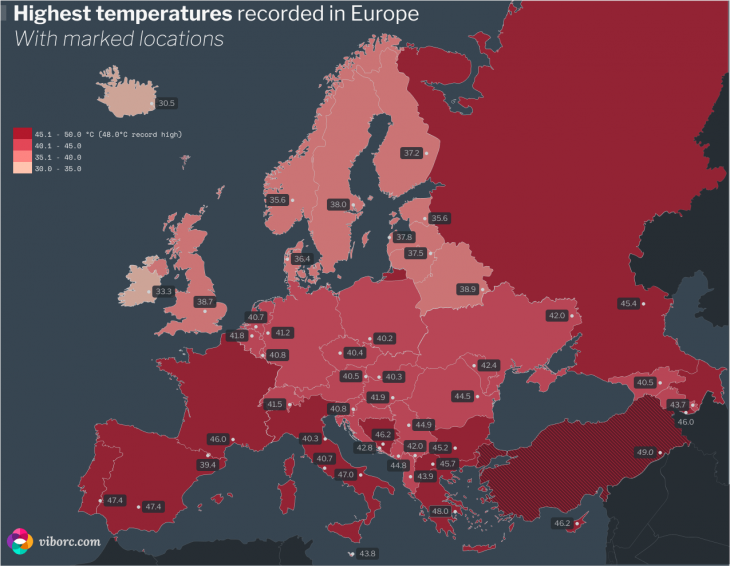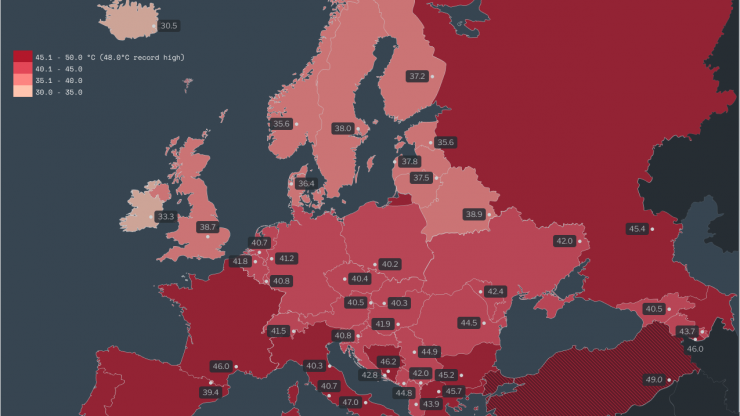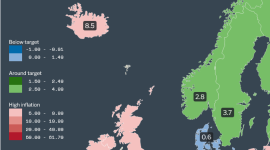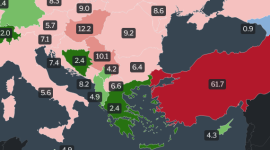What are the highest temperatures recorded in European countries?
UPDATE #1: July 19, 2022 – The UK just recorded its new highest temperature record of 40.3 °C (104.5 °F)
UPDATE #2: Potentially, a new European record was set on August 11, 2021, in Italy. If confirmed by the WMO, it will replace Athens. Read more about this.
UPDATE #3: Spain hits the new highest temperature record, set on August 14, 2021, and confirmed two days later.
At the moment of writing this article (June 2021, updated in July 2022), large parts of southern and central Europe are experiencing a heatwave. Temperatures are expected to hit 37 °C- 39 °C in some areas. While this heatwave will likely set no new highest temperature records in, it is a good moment to explore the highest recorded temperatures in Europe.
According to the WMO, the highest temperature ever recorded in Europe was 48.0 °C in Greece (Athens) on July 10, 1977. Coincidently, July 10 is the anniversary of the highest temperature ever recorded on Earth.
The map also shows the temperature of 49 °C recorded in Turkey – however, since this temperature was recorded in the Asian part of Turkey, it is not considered a European record. The map will be updated as soon as the UK’s MetOffice officially confirms its new national record set on July 19, 2022.

Southern Europe dominates the map
As expected, southern Europe tops the list of highest temperatures recorded in Europe. From Europe’s record in Greece, all the way to 47.4 °C in Portugal, 47.4 °C in Spain (set on August 14, 2021), 47.0 °C in Italy, and 46 °C in southern France – this part of our continent can be scorching hot.
Balkan countries
Balkan countries also get some hot summers. Bosnia and Herzegovina tops the list with the record from Mostar set on July 31, 1901, measuring 46.2 °C. North Macedonia is a close second with 45.7 °C, followed by the Bulgarian record of 45.2 °C. Serbia was just 0.1 °C ahead of its southern neighbor Montenegro where record temperatures of 44.8 °C were recorded in at least two situations. The first time in Podgorica (August 16, 2007) and then five years later (August 8, 2012) in Danilovgrad.
Albania‘s record is at 44.8 °C, with its northern neighbor Kosovo standing at 42.0 °C.
Central Europe
Being at the crossroads of Meditteranean (Southern Europe) and Central Europe, Croatia holds the highest temperature recorded in this region. Its national record of 42.8 °C was recorded in Ploče on August 5, 1981. All other countries from this region also have their highs above 40 °C – from 41.9 °C in Hungary to 40.2 in Poland.
Eastern Europe
Russia tops the list (its European part) with a recorded high of 45.4 °C. That is 0.9 °C above the Romanian national record of 44.5 °C. Belarus is the only country in this region with a national record below 40 °C – standing at 38.9
Baltics and Nordics
As expected, milder highest temperature records are expected in this region. Iceland, truly a land of ice, has the lowest record in Europe, with its record high reaching 30.5 °C – that is 17.5 °C colder than Europe’s record from Greece. The highest temperature recorded in this region is from Sweden. There have been at least two occasions when Sweden recorded 38.0 °C as the highest temperature ever. The first time it happened was on July 9, 1933 (Ultuna), and the second time was on June 29, 1947, in Målilla.
Western Europe
Due to the Atlantic ocean’s effects and milder climate, Ireland‘s record is 33.3 °C – making it the only second country in Europe (after Iceland) with the highest temperature ever recorded, not reaching over 35 °C.
The UK got its new national record of 40.3 °C in 2022, while all Belenux countries also have their record highs above 40 degrees – from 41.8 °C in Belgium to 40.7 in the Netherlands. Neighbouring Germany boasts 41.2 °C as their recorded high, only 0.3 °C lower than Switzerland‘s national record standing at 41.5 °C.
Table of highest temperatures recorded for European countries
| COUNTRY | TEMPERATURE | LOCATION | DATE |
|---|---|---|---|
| Albania | 43.9 °C (111.0 °F) | Kuçovë | 18 July 1973 |
| Andorra | 39.4 °C (102.9 °F) | Borda Vidal | 28 June 2019 |
| Armenia | 43.7 °C (110.7 °F) | Meghri | 1 August 2011 |
| Azerbaijan | 46.0 °C (114.8 °F) | Julfa & Ordubad | … |
| Austria | 40.5 °C (104.9 °F) | Bad Deutsch-Altenburg | 8 August 2013 |
| Belarus | 38.9 °C (102.0 °F) | Gomel | 7 August 2010 |
| Belgium | 41.8 °C (107.2 °F) | Begijnendijk | 25 July 2019 |
| Bosnia and Herzegovina | 46.2 °C (115.2 °F) | Mostar | 31 July 1901 |
| Bulgaria | 45.2 °C (113.4 °F) | Sadovo | 5 August 1916 |
| Croatia | 42.8 °C (109.0 °F) | Ploče | 5 August 1981 |
| Cyprus | 46.2 °C (115.2 °F) | Nicosia | 4 September 2020 |
| Czech Republic | 40.4 °C (104.7 °F) | Dobřichovice | 20 August 2012 |
| Denmark | 36.4 °C (97.5 °F) | Holstebro | 10 August 1975 |
| Estonia | 35.6 °C (96.1 °F) | Võru | 11 August 1992 |
| Finland | 37.2 °C (99.0 °F) | Joensuu Airport | 29 July 2010 |
| France | 46.0 °C (114.8 °F) | Vérargues & Hérault | 28 June 2019 |
| Georgia | 40.5 °C (104.9 °F) | Tbilisi | ?? July 2018 |
| Germany | 41.2 °C (106.2 °F) | Duisburg-Baerl & Tönisvorst | 25 July 2019 |
| Greece | 48.0 °C (118.4 °F) | Athens | 10 July 1977 |
| Hungary | 41.9 °C (107.4 °F) | Kiskunhalas | 20 July 2007 |
| Iceland | 30.5 °C (86.9 °F) | Teigarhorn | 22 June 1939 |
| Ireland | 33.3 °C (91.9 °F) | Kilkenny Castle | 26 June 1887 |
| Italy | 47.0 °C (116.6 °F) | Foggia | 25 June 2007 |
| Latvia | 37.8 °C (100.0 °F) | Ventspils | 4 August 2014 |
| Lithuania | 37.5 °C (99.5 °F) | Zarasai | 30 July 1994 |
| Luxembourg | 40.8 °C (105.4 °F) | Steinsel | 25 July 2019 |
| Malta | 43.8 °C (110.8 °F) | Malta Int’l Airport | 9 August 1999 |
| Moldova | 42.4 °C (108.3 °F) | Fălești | 7 August 2012 |
| Montenegro | 44.8 °C (112.6 °F) | Podgorica & Danilovgrad | 16 Aug 2007, 8 Aug 2012 |
| Netherlands | 40.7 °C (105.3 °F) | Gilze en Rijen | 25 July 2019 |
| North Macedonia | 45.7 °C (114.3 °F) | Demir Kapija | 24 July 2007 |
| Norway | 35.6 °C (96.1 °F) | Nesbyen | 20 June 1970 |
| Poland | 40.2 °C (104.4 °F) | Prószków | 29 July 1921 |
| Portugal | 47.4 °C (117.3 °F) | Amareleja | 1 August 2003 |
| Romania | 44.5 °C (112.1 °F) | Ion Sion | 10 August 1951 |
| Russia (in Europe) | 45.4 °C (113.7 °F) | Utta | 12 July 2010 |
| San Marino | 40.3 °C (104.5 °F) | Serravalle | 3 and 9 August 2017 |
| Serbia | 44.9 °C (112.8 °F) | Smederevska Palanka | 24 July 2007 |
| Slovakia | 40.3 °C (104.5 °F) | Hurbanovo | 20 July 2007 |
| Slovenia | 40.8 °C (105.4 °F) | Cerklje ob Krki | 8 August 2013 |
| Spain | 47.4 °C (117.3 °F) | Montoro | 14 August 2021 |
| Sweden | 38.0 °C (100.4 °F) | Ultuna & Målilla | 9 July 1933, 29 June 1947 |
| Switzerland | 41.5 °C (106.7 °F) | Grono | 11 August 2003 |
| Turkey | 49.0 °C (120.2 °F) | Cizre | 27 August 1961 |
| Ukraine | 42.0 °C (107.6 °F) | Luhansk | 12 August 2010 |
| United Kingdom | 40.3 °C (104.5 °F) | Coningsby | 19 July 2022 (TBC) |
| Vatican City | 40.7 °C (105.3 °F) | Vatican City | 2 August 2017 |
While the best effort was made to check the data and temperature values, there might be some errors. Therefore, if you notice an error, feel free to reach out and let me know – shout at me on Twitter – I am happy to update the maps.
ABOUT THE AUTHOR












